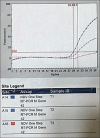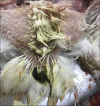Isolation and molecular identification of wild Newcastle disease virus isolated from broiler farms of Diyala Province, Iraq
- PMID: 32158148
- PMCID: PMC7020111
- DOI: 10.14202/vetworld.2020.33-39
Isolation and molecular identification of wild Newcastle disease virus isolated from broiler farms of Diyala Province, Iraq
Abstract
Background and aim: Newcastle disease virus (NDV) remains a major viral disease of poultry. The morbidity and mortality rates of chickens vaccinated with NDV in broiler farms in Diyala Province were 100% and 80%, respectively, rates due to suspected infection with the highly virulent NDV. The present study aimed to isolate and identify the NDV virus and evaluate its pathogenicity in infected broiler chickens at poultry farms.
Materials and methods: Broiler chickens at two commercial poultry farms were suspected of being infected with virulent NDV due to high mortality rates. Virus isolated from samples of intestinal tissues, lungs, trachea, spleen, kidneys, and air sacs was adapted in the allantoic cavity of embryonated specific-pathogen-free (SPF) chicken eggs. The NDV pathotype was determined based on the mean death time (MDT) in eggs as well as the intracerebral pathogenicity index (ICPI) and intravenous pathogenicity index pathogenicity indexes of the isolated samples. Broilers were experimentally infected by inoculation with fluids collected from the allantoic cavities of 60 broilers aged 35 days. Serological and molecular tests were followed by enzyme-linked immunosorbent assay to determine levels of anti-NDV immunoglobulin G, and isolates were identified using a hyperimmune (HI) test and real-time polymerase chain reaction (RT-PCR).
Results: Suspected and isolated NDV field samples propagated in the allantoic cavity of 10-day-old fertile SPF chickens were NDV positive in the rapid hemagglutination test within a few seconds. Pathogenicity indices and MDT showed that the isolated NDV was viscerotropic and velogenic. The virus was identified as NDV by the HI test using specific anti-LaSota HI serum and RT-PCR with specific primers and probes. Propagation of the virus in the allantoic cavity of embryonated hen eggs produced a viral titer of 109.5 EID50/0.1 mL.
Conclusion: The virus isolated from broiler chicken farms in Diyala Province, Iraq, was viscerotropic and velogenic according to the pathogenicity indices and RT-PCR. The isolated NDV caused 100% morbidity and 90% mortality in NDV-vaccinated and experimentally infected broiler chickens.
Keywords: Diyala Province; Newcastle disease virus; pathogenicity; real-time polymerase chain reaction.
Copyright: © Alazawy and Ajeeli, et al.
Figures





Similar articles
-
Molecular characterization of velogenic viscerotropic Ranikhet (Newcastle) disease virus from different outbreaks in desi chickens.Vet World. 2017 Mar;10(3):319-323. doi: 10.14202/vetworld.2017.319-323. Epub 2017 Mar 17. Vet World. 2017. PMID: 28435194 Free PMC article.
-
Pathogenesis of Velogenic Genotype VII.1.1 Newcastle Disease Virus Isolated from Chicken in Egypt via Different Inoculation Routes: Molecular, Histopathological, and Immunohistochemical Study.Animals (Basel). 2021 Dec 15;11(12):3567. doi: 10.3390/ani11123567. Animals (Basel). 2021. PMID: 34944344 Free PMC article.
-
Characterization of the dominant strain (G-VII) of Newcastle disease viruses isolated from commercial chickens in Bangladesh during recent outbreaks.J Adv Vet Anim Res. 2024 Jun 9;11(2):408-417. doi: 10.5455/javar.2024.k790. eCollection 2024 Jun. J Adv Vet Anim Res. 2024. PMID: 39101070 Free PMC article.
-
First report of the emergence of novel sub-genotype XIII.2.3 of Newcastle disease virus in chickens from selected regions of Bangladesh.Infect Genet Evol. 2025 Jun;130:105742. doi: 10.1016/j.meegid.2025.105742. Epub 2025 Mar 20. Infect Genet Evol. 2025. PMID: 40120636
-
Review detection of Newcastle disease virus.Front Vet Sci. 2022 Aug 2;9:936251. doi: 10.3389/fvets.2022.936251. eCollection 2022. Front Vet Sci. 2022. PMID: 35982920 Free PMC article. Review.
Cited by
-
Cell-derived Newcastle disease virus variant with two amino acid substitutions near cleavage site of F shows favorable traits as oncolytic virus.Mol Ther Oncol. 2024 Dec 6;33(1):200915. doi: 10.1016/j.omton.2024.200915. eCollection 2025 Mar 20. Mol Ther Oncol. 2024. PMID: 39802675 Free PMC article.
-
Evaluation of vero and chicken embryo fibroblast cell-based newcastle disease vaccine efficacy in chickens.Poult Sci. 2025 Jul 29;104(10):105624. doi: 10.1016/j.psj.2025.105624. Online ahead of print. Poult Sci. 2025. PMID: 40782609 Free PMC article.
-
Phylogenetic studies of Newcastle disease virus isolated from poultry flocks in South Sulawesi Province, Indonesia, in 2019.J Adv Vet Anim Res. 2021 Mar 7;8(1):129-137. doi: 10.5455/javar.2021.h495. eCollection 2021 Mar. J Adv Vet Anim Res. 2021. PMID: 33860023 Free PMC article.
-
Monitoring of Newcastle Disease Virus Vaccine Strain Replication in Embryonated Chicken Eggs by Reverse Transcription-Polymerase Chain Reaction.Arch Razi Inst. 2023 Apr 30;78(2):767-773. doi: 10.22092/ARI.2022.359142.2377. eCollection 2023 Apr. Arch Razi Inst. 2023. PMID: 37396741 Free PMC article.
-
Exploring the genetic basis of Newcastle disease virus in chickens: a comprehensive review.Front Immunol. 2025 Jun 27;16:1614794. doi: 10.3389/fimmu.2025.1614794. eCollection 2025. Front Immunol. 2025. PMID: 40655137 Free PMC article. Review.
References
-
- Ashraf A, Shah M.S. Newcastle disease:Present status and future challenges for developing countries. Afr. J. Microbiol. Res. 2014;8(5):411–416.
-
- Alexander D.J, Senne D.A. Newcastle disease, other avian paramyxoviruses, and pneumovirus infections. In: Saif Y.M, Fadly A.M, Glisson J.R, McDougald L.R, Nolan N.K, Swayne D.E, editors. Diseases of Poultry. 12th ed. Ames, IA: Blackwell Publishing; 2008. pp. 75–115.
-
- Suarez D.L, Miller P.J, Koch G, Mundt E, Rautenschlein S. Diseases of Poultry. USA: WILEY Blackwell; 2013. Newcastle Disease, other Avian Paramyxoviruses, and Avian Metapneumovirus Infections; pp. 857–138.
-
- Smietanka K, Olszewska M, Domanska-Blicharz K, Bocian A.L, Minta Z. Experimental infection of different species of birds with pigeon paramyxovirus type 1 virus evaluation of clinical outcomes, viral shedding, and distribution in tissues. Avian Dis. 2014;58(4):523–530. - PubMed
LinkOut - more resources
Full Text Sources
